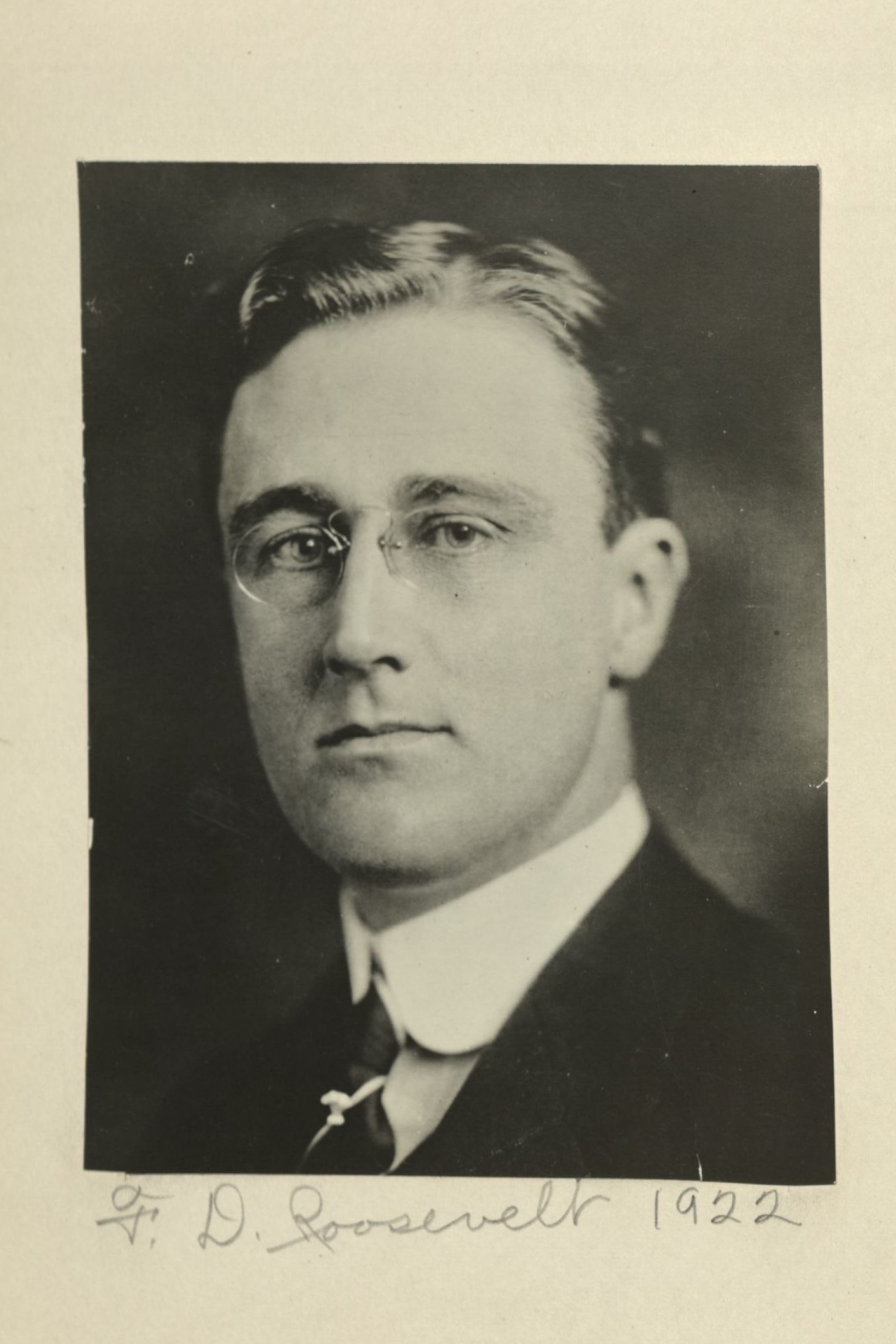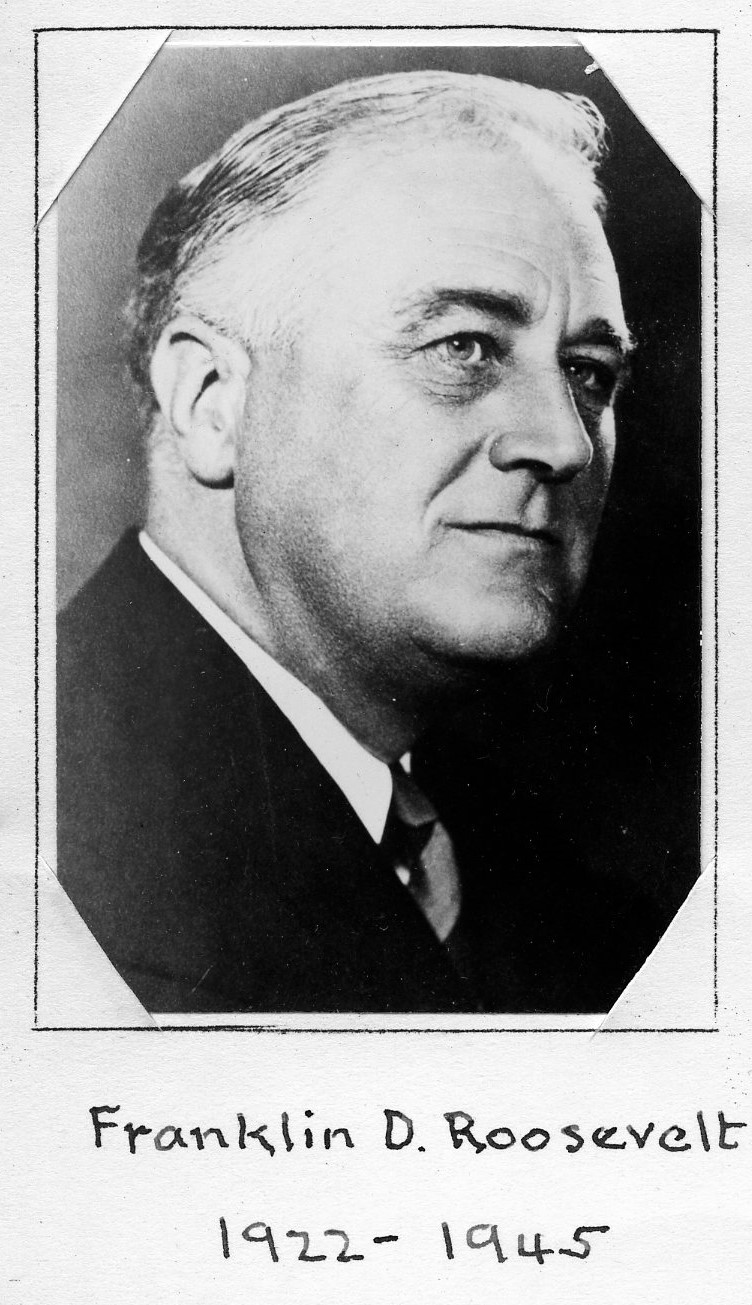Lawyer/Governor of New York/U.S. President
Centurion, 1922–1945
Born 30 January 1882 in Hyde Park, New York
Died 12 April 1945 in Warm Springs, Georgia
Buried Franklin D. Roosevelt National Historic Site , Hyde Park, New York
, Hyde Park, New York
Proposed by Robert Grier Monroe and John G. Milburn
Elected 14 January 1922 at age thirty-nine
Archivist’s Note: Son of James Roosevelt; half-brother of James R. Roosevelt; nephew of Frederic A. Delano; nephew-in-law of Theodore Roosevelt; great-nephew of William H. Aspinwall, Edward Delano, and Franklin H. Delano
Century Memorials
Franklin Delano Roosevelt. [Born] 1882. President of the United States.
Inaugurated at the grayest moment of an economic crisis which threatened the security of the Republic, he twice preserved his country, was three tines reelected to the presidency and died in office in his country’s greatest war, having lived to see the victory assured but not to share it.
Fearless in his own person, he inspired in his people the contempt of fear.
Courageous and honest in the observation of his time, he led his generation to an understanding of the choice with which the time confronted it.
Strong willed and stubborn of purpose, he chose the men and framed the plans to bring to bear upon his country’s enemies the full and overwhelming power of its strength, turning the first and terrible defeats to victories unprecedented in the history of war.
Trustful of the common decency of men and hopeful for the future of mankind, he renewed in his own land the faith in freedom and self-government and planned the union of the nations of the earth.
He died the first citizen of his country and the world.
Source: Henry Allen Moe Papers, Mss.B.M722. Reproduced by permission of American Philosophical Society Library & Museum, Philadelphia
Henry Allen Moe
Henry Allen Moe Papers, 1945 Memorials
Roosevelt was born in Hyde Park to Sara and James Roosevelt, both of whom were from wealthy and aristocratic families. Franklin attended Groton, Harvard and Columbia Law School, and on St. Patrick’s Day 1905 he married Eleanor Roosevelt, a fifth cousin once removed. Eleanor’s uncle, Theodore Roosevelt (also Franklin’s cousin), stood in at the wedding for Eleanor’s deceased father Elliott.
Franklin entered politics in 1910, winning election to the state Senate. In 1913, President Woodrow Wilson appointed him Assistant Secretary of the Navy, a position he retained until 1920. At the Democratic convention he was picked as the vice presidential candidate to run with James M. Cox, but the Republicans and Harding won the election.
In the summer of 1921, disaster hit—he was stricken with polio. He fought valiantly to regain the use of his legs, mostly through swimming, and at the 1924 Democratic convention he dramatically appeared on crutches to nominate Alfred E. Smith as “the happy warrior.” In 1928, Roosevelt became New York’s Governor, and he was reelected in 1930.
Roosevelt won the nomination for President in 1932, and, with the Depression an election issue, he defeated Herbert Hoover. He named William H. Woodin to the important Secretary of the Treasury post, and in the first hundred days Roosevelt pushed through the New Deal, a sweeping program. By 1935 the country had achieved some measure of recovery, and in 1936 he was reelected by a wide margin.
The two-term tradition had been an unwritten rule since George Washington declined to run for a third term in 1796, but Roosevelt skillfully undercut prominent Democrats who were after the nomination in 1940. He was nominated at the convention and easily defeated Republican Wendell Willkie.
By mid-1941, Roosevelt had committed the U.S. to the Allied side with a policy of “all aid short of war.” He ordered Henry L. Stimson, Secretary of War, to begin planning for total American involvement, and when the Japanese attacked Pearl Harbor, Roosevelt directed his country’s resources for a global war.
In 1944, FDR was in declining health and, with the little-known Harry Truman replacing the pro-Soviet Henry Wallace as Vice President, he won a fourth term defeating Governor Thomas Dewey. On April 12, 1945, Roosevelt died in Warm Springs, Georgia. That year Centurions purchased a silver cup in memory of FDR, which was famously misinscribed “Franklyn D. Roosevelt.” Despite the cup being replaced a few times, the error has faithfully been retained.
James Charlton
“Centurions on Stamps,” Part I (Exhibition, 2010)


